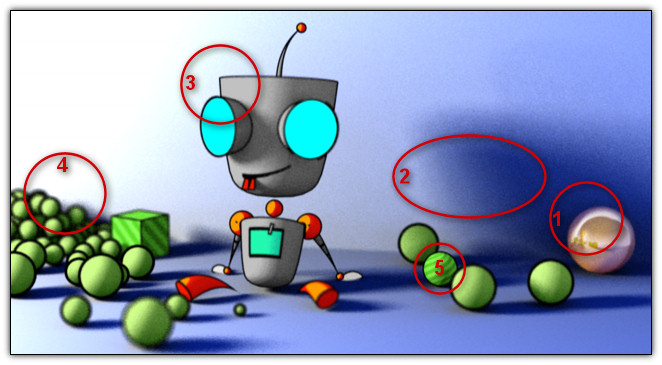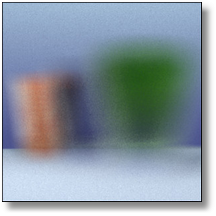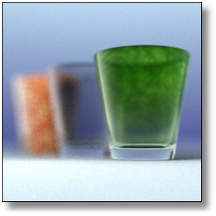Brazil r/s feature list
This image was rendered in Brazil for Rhino, and it shows
advanced features that you will not find in simpler rendering
platforms:

The five details highlighted in this image represent an
advanced feature: (1) Raytracing, (2) Advanced lighting, (3)
Toon rendering, (4) Depth of field, (5) Procedural textures.
Raytracing Materials
Brazil's render engine uses the raytracing method. Raytracing
has the advantage of simulating the way photons actually behave;
although raytracing is not limited to realistic solutions it
delivers some of the most photorealistic images available on any
platform available today.

Brazil's advanced raytrace
engine simulates a wide range of
effects due to Brazil's
extensive
material model:
Along with the Brazil's
materials, we are introducing a
new interface to edit the
materials that includes realtime
preview and support of drag and
drop material assignment.
|
 |
|
Advanced lighting
Rhino supports point, spot, directional, linear, and
rectangular light objects with simple properties such as color,
hotspot, and shadow casting. Brazil adds about 100 more light
properties. The number of light properties can be intimidating,
but most of these settings are only needed in a few specific
cases.

Brazil light features include:
Brazil will also display
focal cones and attenuation
spheres for selected lights in
the viewport, so you can see the
affects of your settings in
real-time.
Also included with Brazil is our
new Sun control which allows you
to accurately place the sun
anywhere in the world. |
 |
Toon and NPR
Brazil includes non-photoreal (NPR) effects such as
toon shaders. r>

(Car)Toon shaders cooperate with photoreal shaders so you can
mix glass, brushed metal and toon in a single scene without
losing the ability to do indirect-illumination, depth-of-field
or any other effect.
You can specify the behaviour of fills and inks including:
- Multi-level paint fills (discrete colors
applied based on luminosity)
- Gooch type fills, (continuous gradient)
Depth of Field
Depth-of-field (DOF) simulates the imperfect focusing
properties of physical lens-systems such as biological eyes and
cameras. DOF adds a measure of realism to a rendering by
blurring out-of-focus areas. It can also be used to "mask" areas
of the scene such as distant surroundings.

The settings for DOF include:
- Focus distance
- Radius
- F-stop
-
Bokeh abberations (the effect over-exposed
areas in an image have when they are out of
focus)
Depth of Field Details

|
Rhino
viewport
screenshot.
Brazil materials
can be simulated
and displayed in
the real-time
viewport.
|

|
Brazil
rendering with
no DOF effect.
Everything is in
focus. |

|
Depth of
field enabled.
|

|
DOF ith
focal distance
aimed at the
first glass.
|

|
The middle
glass is in
focus. The
depth-of-field
effect blurs
both objects in
front of and
behind the field.
|

|
The field is
centered around
the third object.
|
Procedural Textures
Brazil supports both bitmap and procedural textures. Bitmap
textures use images (a grid of colored pixels). Procedural
textures, on the other hand, are defined by a mathematical
function. Procedural textures do not suffer from resolution or
tiling problems, and it is easy to change their behavior.
Procedural textures are simulated in the Rhino viewport to make
adjustments easy.

Some Brazil built-in functions:
- Checker
- Dots
- Gradient
- Marble
- Noise
- Tile
- Wrinkled
Advanced definitions can be used to create other realistic
materials such as wood and stone.
High Dynamic Range colors
Brazil is a
high-dynamic-range (HDR) engine.

With an HDR rendering engine, colors are not limited to the
black~white range. Colors can be brighter than white and darker
than black. "Brighter-than-white" colors are important even
though the computer screen cannot display them, because colors
in a rendering are often diluted by partial reflection or
refraction.
High-dynamic-range color details

|
No
high-dynamic-range
colors. The
material on the
ball is
partially
reflective,
which means that
the residual
color after
reflection is
about one-fourth
of what it used
to be.
|

|
The white
planes reflected
in the ball have
been given a
brighter-than-white
color.
|

|
The planes are ten times
brighter than
white, so the
resulting color
is also brighter
than white. It
is limited by
the gamut of the
computer screen.
A glowing effect
would visually
enhance the
brightness, is
not actually
possible to
display this
rendering
accurately.
|
Influence of indirect lighting
CoColors can also be diluted through indirect
lighting. This scene is lit both directly (through
a pointlight to the left, which casts the
predominant shadow) and indirectly:
|

|
If the
brightness of
the tube is set
to zero, then it
will be
completely black,
and only the
direct light
emitted from the
pointlight
object plays a
role in this
scene.
|
|

|
The brightness of
the tube has
been set at half
the normal
brightness,
meaning that the
purple-to-pink
gradient on the
tube appears
half as dark.
However, there
is already some
indirect pink
discoloration on
the ground
surrounding the
tube. <
|
|

|
When the
brightness is
set to 1.0, we
see the gradient
fwith a
substantial
amount of
indirect pink,
especially on
the ground
inside the tube
walls, which is
exposed from all
directions. At
this point, this
scene is not yet
HDR.
|
|

|
When we
boost the
brightness of
the tube to
twice its normal
color, the far
end of the tube
(which is
supposed to be
pink) has been
boosted so far
that it becomes
brighter than
white. It's
still pink, but
too bright to be
represented
properly on the
screen.
|
|

|
When we
boost the
brightness to a
factor of five,
the
brighter-than-white
boundary is
located further
towards the dark
end of the
gradient. Also,
the indirect
lighting is now
predominant on
the ground near
the tube to the
point that some
of it has also
breached the
white barrier.
|
|

|
The brightness is
set to one again,
but the strength
and saturation
of the indirect
lighting has
been boosted.
This creates a
physically
incorrect scene
that uses the
HDR features of
Brazil without
specifying HDR
colors.
|
Global Illumination
Global Illumination i is a feature you will find in most
modern rendering platforms including Brazil.

Global Illumination es both direct and indirect
illumination to generate a realistic image. Direct illumination
is the process where light objects cast light onto objects
creating bright areas on surfaces that face the light source,
darker areas on surfaces that do not face the light source, and
shadows when surfaces cannot "see" the light source directly due
to some obstruction. After a surface has been lit directly, it
emits photons and some of those photons are captured by other
surfaces and some of those photons are finally caught by
our eyes or a camera. The effect of indirect illumination is
relatively small compared to that of direct illumination. Yet,
it is very important to the "realistic" quality of the image.
GlGlobal Illumination Details
DiDiffuse light scattering
This example shows color leaking and
luminance in indirect illumination.

|
This image shows the combined
effect of all direct
illumination. Instead of a
number of light objects, this
scene is lit by an unfocused and
diffuse white light (monochromatic
skydome). Our visual cortex
dismisses this image as fake,
since the groundplane and the
sphere (though touching) have
completely different hue and
saturation components.
|

|
When we enable indirect
illumination, the realism of the
rendering increases dramatically.
Both the groundplane and the
sphere are affected by the
indirect light.
|

|
A ose-up of this rendering
shows the dissipation of diffuse
global illumination, since the
effect of an object decreases by
distance (things far away are
smaller than things nearby), the
areas of the groundplane that
are closest to the sphere have
the most contrast, it is in
these regions that we can
clearly see the colored bands of
the sphere. As we move further
away, the orange and green
indirect lighting start to
mingle.
|


